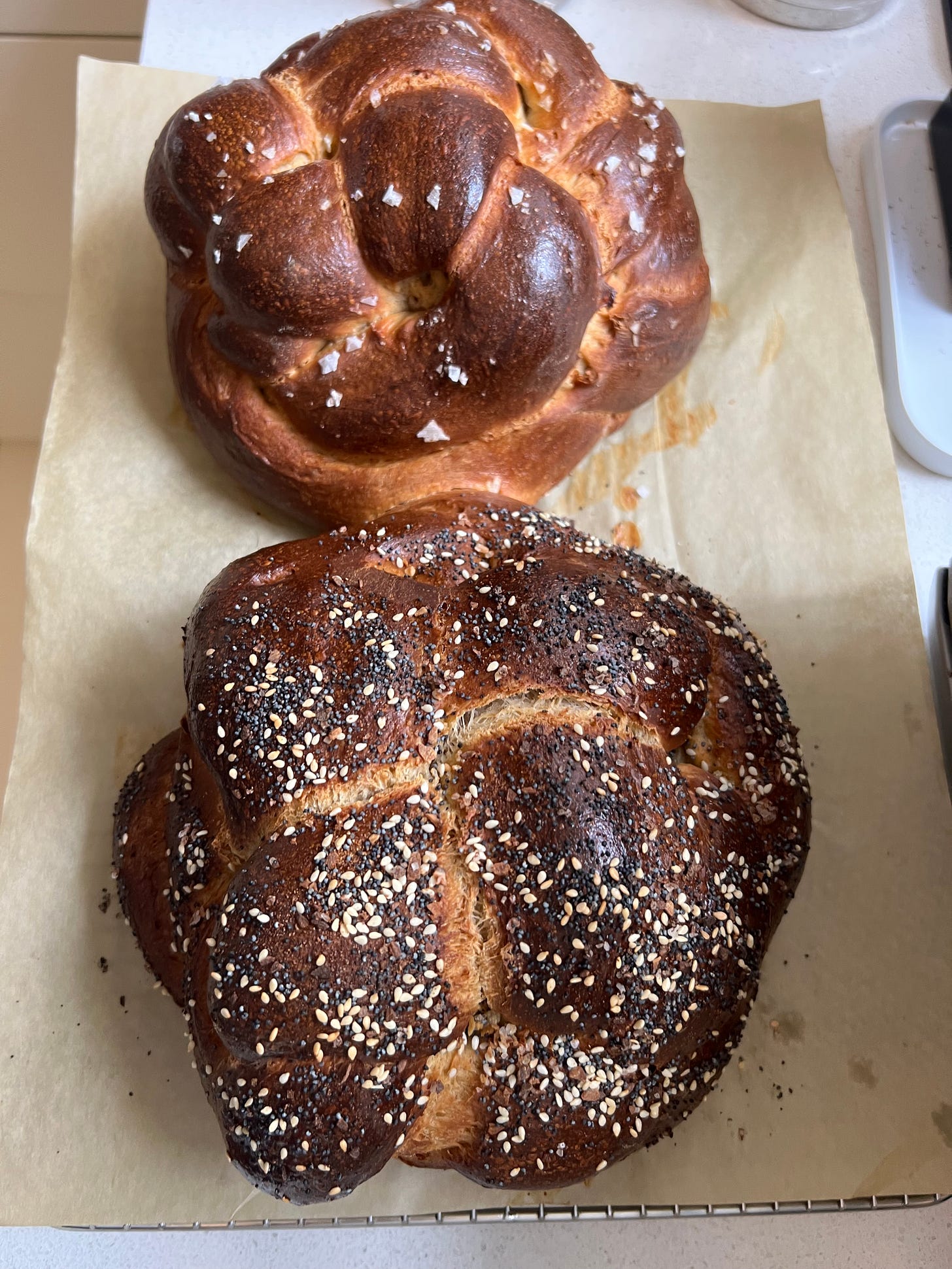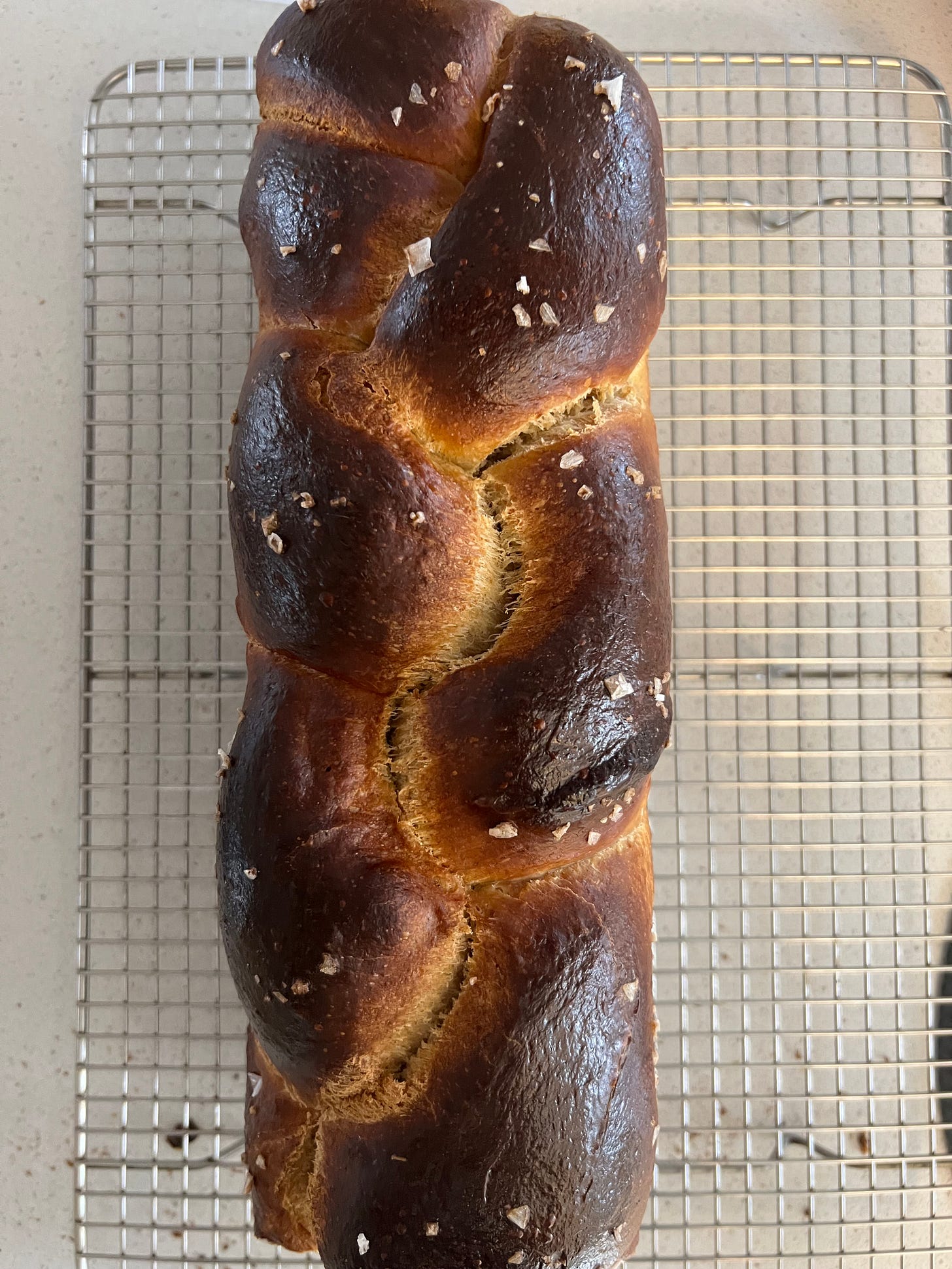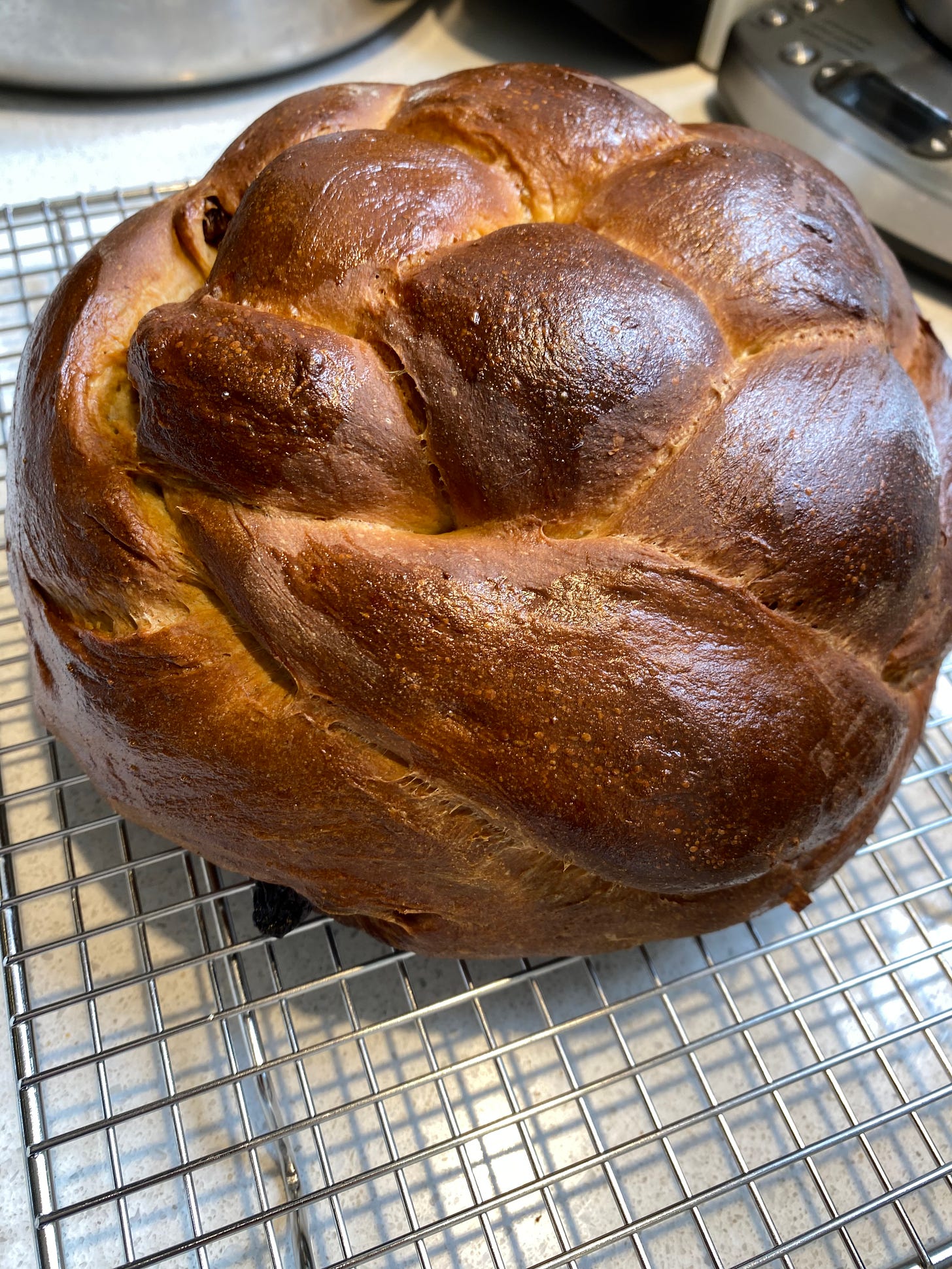Issue #126: In Times Like These, You'll Find Me in the Kitchen
Some Thoughts on What’s Going on in the Middle East, My Recipe for Challah
A friend and colleague of mine in Israel mentioned they had just turned back the clocks one hour for winter. And then she said she wished they could turn them back three weeks. Oh man, wouldn’t that be amazing.
A little more than three weeks ago, I baked these challahs for Rosh Hashana, the Jewish New Year. Challahs are traditionally round at that time of year to represent the cycle of life.
It’s hard to believe how the world has been turned upside down in such a short time.
That cycle was broken on October 7 for more than 1,400 people who were gruesomely murdered by the Hamas terrorist organization in charge of Gaza and unthinkably hundreds more who were kidnapped, many of them peaceniks who’d spent their lives advocating for a resolution to the Palestinian injustices. That was before Israel understandably deemed the brutality an act of war and began its inevitable retaliation. Before the cycle of life was broken for thousands of casualties caught up in this war that wasn’t of their making. Before the propaganda, misinformation, and lies began circulating, not only on social media, but also in traditional media, and then within social circles, among families, friends, and colleagues. Before the backlash against Israel and global swell of antisemitism and islamophobia that has cost people their friends, in some cases their jobs, and lead to the loss of additional life.
Another friend asked why I haven’t posted anything about the situation. Where to begin?
I am a Jew. I stand with Israelis. I also stand with Palestinians. I stand with everyone who wants to live a rewarding, fulfilling, peaceful life free from oppression and persecution and who does not oppress or persecute to achieve it. I stand against brutality, terrorism, injustice of any kind, no matter who is responsible. I don’t believe in war, but I do understand how politically sometimes it is unavoidable. I know that you don’t have to look back very far in history to know that, sadly, no country has been built on moral ground free from egregious acts that have contaminated the soil. This is not a justification, but an acknowledgment that until we humans evolve beyond our primitive tribal instincts, we are bound to repeat our costly, heartbreaking mistakes. It’s hard sometimes, in these times, to remain optimistic that such a time will ever come.
So, I am writing about challah this week. Baking bread makes me happy. I feel as though it connects me to thousands of years of history and tradition. And when I think about all that we have lived through during that time, and still the yeast rises, I can sometimes find hope in a simple loaf. But it isn’t easy.
Honestly, I haven’t written anything about what’s going on, in part, because it’s all so difficult to believe. On October 6, my birthday, I received greetings from friends in Israel enjoying a holiday Shabbat. And then, quite literally, all hell broke loose. On the one hand, this is utter madness. On the other, if it was all so predictable, it must follow a certain warped logic. Hamas’s unfathomable but carefully planned brutality set into motion a chain of events that everyone could have predicted. So, how exactly are they not the bad guys here? And yet increasingly many seem to believe somehow Israel is to blame.
It makes think about how when I was a little kid, my sister and I would play fight. Sometimes it got a little rough. Leslie would have me pinned on the floor of the living room, unable to move, and my mother would yell, “Mitchell, enough is enough.”
I watch in disbelief as many in my community of food professionals take the side of the perpetrators of this horrific act. I wonder how they might feel if it was their child who had been decapitated, their aunt who was kidnapped, their home that was burned. If you are a truly empathetic person, I don’t see how you can turn it on and off. You ought to be able to feel for everyone. Though I could understand why you might not want to. It hurts too much.
Having worked for several years now on two substantial projects in Israel designed to use food as a way to build bridges and honor our collective humanity by exploring different aspects of our food culture, I have delved deeper into this complicated part of the world than many who have fired off righteous statements of support for one side or the other. I came to these projects because of my belief in the power of food, not because I had some blind love of Israel, a place I had little connection to prior to my engagement in the work I was asked to perform.
To become better informed, I’ve read many books and countless articles. I interviewed Israelis and Palestinians, I met with cultural organizations on all sides of the political spectrum, I made many close friends. I still don’t claim to have anything but a superficial grasp of the social, political, economic, and historical complexity of the situation in the region before this war. I have little idea what it’s like to go about one’s daily life knowing that at any moment a spark could light a fire that would burn the entire place down. I know so many people who worked to ensure that would never happen. Caring, smart, open, innovative, talented people working to make a difference. And then, overnight, everything was aflame.
I believe that antisemitism and islamophobia are very real and very dangerous. Now we know how pervasive they really are. Like racism, they are insidious and find their way into systems of logic and morality that seem totally natural, neutral even, until we unpack how we’ve came to believe that things are so. This unpacking can take decades, centuries. We have the all-too vivid examples of slavery and the Holocaust to remind us of how potent and destructive these forces can be. We’ve had 400 years to reconcile the former, and as I type this I’m sitting in Florida (at a Taoist Tai Chi® workshop), where they have banned the teaching of black history.
For anyone with any sense of what is happening on either side in this conflict, the situation is overwhelming. The news conjures too many emotions to process, ranging from anger and grief to disappointment and despair. Fear and dread are everywhere. And I’m just watching it from afar. Everyone who knows anyone in Israel is connected to someone murdered, kidnapped, or called to war, just as I’m sure anyone who knows anyone in Gaza has an equally grim story to tell. This should not be a contest.
Yesterday I got a text from another dear friend, a Lebanese woman who lives on the other side of the world in New Zealand. “It’s times like this,” she wrote, “I think of your gracious table set with a Lebanese table cloth and Israeli dinner set, believing even more in the power of such generosity, hospitality and commensality. What happened on October 7th was an unforgivable act of brutality and terrorism. My heart goes out to all whose political and world leaders can’t find a solution that puts humanity, freedom and empathy first. This is where the table plays its best role.” It made me cry.
In times like these I find my own peace in the kitchen, cooking and baking to stay connected to what remains of our humanity. I believe in the power of food.
RECIPE: Challah
1 cup lukewarm water (around 120°F., or warm to the touch)
2 teaspoons instant yeast
1/4 cup sugar
2 large eggs, room temperature
¼ cup extra-virgin olive oil
4 ½ cups unbleached all-purpose or bread flour
1 tablespoon kosher salt
Egg wash
Sesame, poppy or other seeds, flaky salt, everything spice, or another topping
In the bowl of an electric stand mixer, combine the water, yeast, sugar, eggs, olive oil, 4 cups of the flour, and the salt (in that order, to keep the salt apart from the yeast). With the dough hook attachment of the mixer, mix on low speed until a stiff dough forms. Keep the mixer running until the dough becomes more cohesive. It will creep up the hook. Periodically, stop the mixer, wet your hand, and pull the dough off the hook. The dough should begin to pull off the sides and the bottom of the bowl. If it doesn’t, add more flour, a little sprinkling at a time. Continue kneading about 6 or 7 minutes, until the dough becomes smooth and elastic.
Lighlty flour a clean work surface. Scrape the dough out of the bowl onto the floured surface. Lightly flour the dough and your hands a knead for a minute or two to finish the challah. Shape into a tight ball by pulling corners of the bread toward the center and rolling it a few times on the work surface. The dough should be soft, smooth, and elastic.
Pour a drop of olive oil in a large, clean bowl. Invert the ball of dough into the bowl, move it around to coat with oil, then invert it again and set it upright in the bowl. Cover the bowl with plastic wrap and a tea towel and let rise in a warm place until double in bulk, about 90 minutes, or more, depending on the temperature of everything. I prefer to err on the side of over proofing in this first rise, so if you aren’t sure if has doubled, keep it going a little longer. Punch down the dough. You can refrigerate it now in a large, airtight container (it will continue to rise) overnight or for up to 2 days.
I’m not going to go into a long explanation of how to shape the dough. There are literally hundreds of videos on the internet for different braids, rounds, rolls, and art pieces made from challah. Here’s a how to braid a round challah, like the one shown.
Place the braided bread on a parchment-lined sheet pan. Cover with a paper towel and set in a warm place to double again. If your dough is cold from the fridge, it can take up to 4 hours. Otherwise, 60 to 90 minutes should do. When you poke it gently, your finger should leave a dent that doesn’t quite go away. This time you don’t want it to be over proofed or the finished texture will be off. Preheat the oven to 425°F. Brush the challah with egg wash and let it dry in the air for 5 to 10 minutes. Brush it again with wash for a shiny finish. Sprinkle with your desired topping, seeds or salt or nothing, as you prefer.
Place in the preheated oven to bake for 25 minutes. it should rise and begin to brown. Turn down the temperature to 375°F. and bake for another 10 to 15 minutes, until the challah is cooked through. I like mine quite dark, as the photos show. An instant-read thermometer inserted in the center should read at least 200°F. to be sure it’s done. Remove from the oven and let cool completely on a wire rack before eating.







Beautifully written, Mitchell. My heart hurts so much. Perhaps making challah will help.